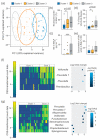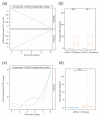Bile Acid Signal Molecules Associate Temporally with Respiratory Inflammation and Microbiome Signatures in Clinically Stable Cystic Fibrosis Patients
- PMID: 33172004
- PMCID: PMC7694639
- DOI: 10.3390/microorganisms8111741
Bile Acid Signal Molecules Associate Temporally with Respiratory Inflammation and Microbiome Signatures in Clinically Stable Cystic Fibrosis Patients
Abstract
Cystic fibrosis (CF) is a congenital disorder resulting in a multisystemic impairment in ion homeostasis. The subsequent alteration of electrochemical gradients severely compromises the function of the airway epithelia. These functional changes are accompanied by recurrent cycles of inflammation-infection that progressively lead to pulmonary insufficiency. Recent developments have pointed to the existence of a gut-lung axis connection, which may modulate the progression of lung disease. Molecular signals governing the interplay between these two organs are therefore candidate molecules requiring further clinical evaluation as potential biomarkers. We demonstrate a temporal association between bile acid (BA) metabolites and inflammatory markers in bronchoalveolar lavage fluid (BALF) from clinically stable children with CF. By modelling the BALF-associated microbial communities, we demonstrate that profiles enriched in operational taxonomic units assigned to supraglottic taxa and opportunistic pathogens are closely associated with inflammatory biomarkers. Applying regression analyses, we also confirmed a linear link between BA concentration and pathogen abundance in BALF. Analysis of the time series data suggests that the continuous detection of BAs in BALF is linked to differential ecological succession trajectories of the lung microbiota. Our data provide further evidence supporting a role for BAs in the early pathogenesis and progression of CF lung disease.
Keywords: bile acids; cystic fibrosis; gut–lung axis; inflammation; lung microbiota.
Conflict of interest statement
The authors declare no conflict of interest. The funders had no role in the design of the study; in the collection, analyses, or interpretation of data; in the writing of the manuscript, or in the decision to publish the results.
Figures



Similar articles
-
Detection of bile acids in bronchoalveolar lavage fluid defines the inflammatory and microbial landscape of the lower airways in infants with cystic fibrosis.Microbiome. 2023 Jun 13;11(1):132. doi: 10.1186/s40168-023-01543-9. Microbiome. 2023. PMID: 37312128 Free PMC article. Clinical Trial.
-
The Detection of Bile Acids in the Lungs of Paediatric Cystic Fibrosis Patients Is Associated with Altered Inflammatory Patterns.Diagnostics (Basel). 2020 May 6;10(5):282. doi: 10.3390/diagnostics10050282. Diagnostics (Basel). 2020. PMID: 32384684 Free PMC article.
-
Systems Biology and Bile Acid Signalling in Microbiome-Host Interactions in the Cystic Fibrosis Lung.Antibiotics (Basel). 2021 Jun 24;10(7):766. doi: 10.3390/antibiotics10070766. Antibiotics (Basel). 2021. PMID: 34202495 Free PMC article. Review.
-
Airway microbiota across age and disease spectrum in cystic fibrosis.Eur Respir J. 2017 Nov 16;50(5):1700832. doi: 10.1183/13993003.00832-2017. Print 2017 Nov. Eur Respir J. 2017. PMID: 29146601 Free PMC article.
-
Microbiome in the pathogenesis of cystic fibrosis and lung transplant-related disease.Transl Res. 2017 Jan;179:84-96. doi: 10.1016/j.trsl.2016.07.022. Epub 2016 Aug 4. Transl Res. 2017. PMID: 27559681 Review.
Cited by
-
Detection of bile acids in bronchoalveolar lavage fluid defines the inflammatory and microbial landscape of the lower airways in infants with cystic fibrosis.Microbiome. 2023 Jun 13;11(1):132. doi: 10.1186/s40168-023-01543-9. Microbiome. 2023. PMID: 37312128 Free PMC article. Clinical Trial.
-
Accommodating multiple potential normalizations in microbiome associations studies.BMC Bioinformatics. 2023 Jan 19;24(1):22. doi: 10.1186/s12859-023-05147-w. BMC Bioinformatics. 2023. PMID: 36658484 Free PMC article.
-
Efflux, Signaling and Warfare in a Polymicrobial World.Antibiotics (Basel). 2023 Apr 8;12(4):731. doi: 10.3390/antibiotics12040731. Antibiotics (Basel). 2023. PMID: 37107093 Free PMC article. Review.
-
The changing metabolic landscape of bile acids - keys to metabolism and immune regulation.Nat Rev Gastroenterol Hepatol. 2024 Jul;21(7):493-516. doi: 10.1038/s41575-024-00914-3. Epub 2024 Apr 4. Nat Rev Gastroenterol Hepatol. 2024. PMID: 38575682 Free PMC article. Review.
-
The Gut-Lung Axis in Cystic Fibrosis.J Bacteriol. 2021 Sep 23;203(20):e0031121. doi: 10.1128/JB.00311-21. Epub 2021 Aug 2. J Bacteriol. 2021. PMID: 34339302 Free PMC article. Review.
References
-
- Ranganathan S.C., Hall G.L., Sly P.D., Stick S.M., Douglas T.A., Australian Respiratory Early Surveillance Team for Cystic, F Early Lung Disease in Infants and Preschool Children with Cystic Fibrosis. What Have We Learned and What Should We Do about It? Am. J. Respir. Crit. Care Med. 2017;195:1567–1575. doi: 10.1164/rccm.201606-1107CI. - DOI - PMC - PubMed
Grants and funding
LinkOut - more resources
Full Text Sources

